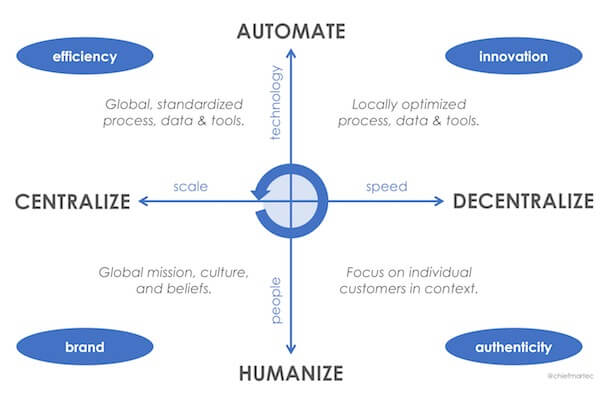For Scott Brinker, marketing is designed to balance the ‘4 Forces’
In a recent essay, the MarTech Conference chair pointed to the necessary give-and-take between automation and humanization, centralization and decentralization.
Like some physicist discovering the hidden nature of marketing, Scott Brinker recently unveiled his own theory of the relativity of opposing forces.
In preparation for our MarTech® Conference next week in Boston, where HubSpot VP Brinker is conference chair, he posted last month a thought piece on “The 4 Forces of Marketing Operations & Technology.”
As marketers face rapid change, he said, there are two sets of opposing forces that must be balanced:
Don’t these two sets of competing forces, I recently asked Brinker, affect virtually every dynamic system, whether marketing, politics or the stock market?
Or is there something intrinsic to marketing that creates this perpetual balancing act?
Centralization to make decentralization possible. It may exist broadly across all kinds of systems, he replied, but it’s particularly endemic to the field of marketing. And it’s a push/pull, not an either/or.
“You centralize the right things,” he said, “and then it makes greater decentralization possible.”
Take Customer Data Platforms (CDPs), he said. They are centralized systems that bring key customer profile data into one system, but, by doing so, they make that data available to anyone.
Even blockchain, whose purpose is providing a decentralized ledger, operates on a centrally agreed-upon protocol.
Automation for personalization, humans for personality. Automation, he noted, “makes a better experience, [and] customers love self-service when it works for them.”
When it doesn’t, cue the humans.
But, even if automation a hundred years from now works perfectly 100 percent of the time, customers appreciate human interaction — or whatever effectively pretends to be human.
Like T-Mobile’s recent announcement that human agents are now available to all customers who so desire, brands are recognizing that the human touch — even when it comes with some friction — can add a distinctive personality.
At the same time, automation does more than replace customer service agents; it makes possible the marketers’ goal of personalization at scale.
“All data is not equal.” In short, marketing depends on these dualities, all of which orbit around the most important piece of data for a customer-facing business:
Identity.
“All data is not equal,” Brinker pointed out. A survey about marketing salaries, for instance, might need to remain localized inside the human resources department, and not centralized or distributed.
“But identity matters more than anything else,” he added. “Everyone who’s touching a customer [has to agree] that it’s the same customer.”
It needs to be centralized for consistency and decentralized for usability, and it needs automation to deliver personalized experiences that are tempered by human interaction when the automation fails to provide the unique experience.
In fact, it’s all about the customer experience, the sum of interactions between brand and customer/would-be customer that every modern brand realizes is the key in an age when a mouse click can locate a competing product.
My experience with the brand needs to be consistently personalized across the board and efficient through self-service, except where human interaction is beneficial.
It may be that other dynamic systems can similarly claim the need to balance between the Four Forces identified by Brinker, but customer identity and experience have made these dualities part of the standard model for how modern marketing operates.
Contributing authors are invited to create content for MarTech and are chosen for their expertise and contribution to the martech community. Our contributors work under the oversight of the editorial staff and contributions are checked for quality and relevance to our readers. MarTech is owned by Semrush. Contributor was not asked to make any direct or indirect mentions of Semrush. The opinions they express are their own.
Related stories
New on MarTech

